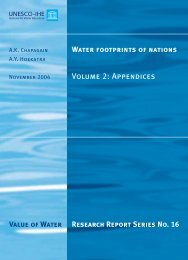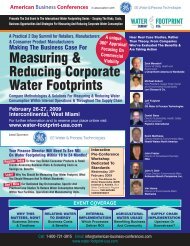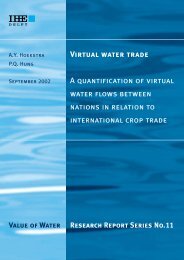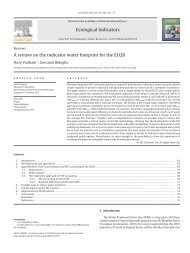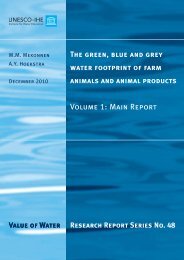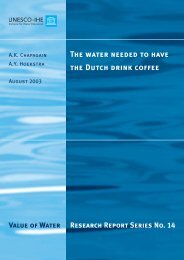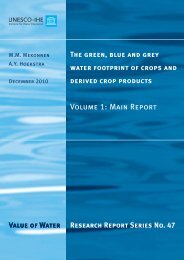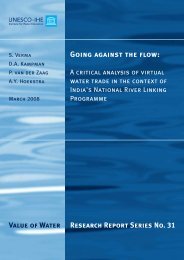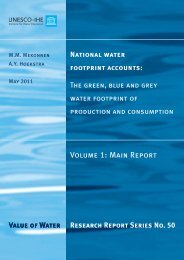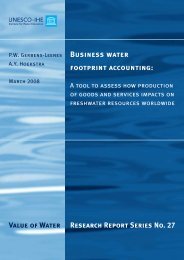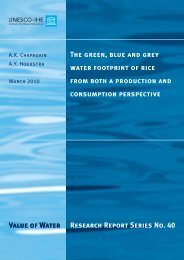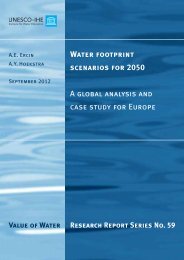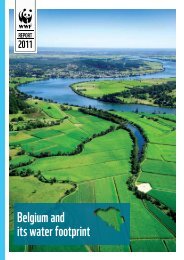The water footprint of soy milk and soy burger and equivalent animal ...
The water footprint of soy milk and soy burger and equivalent animal ...
The water footprint of soy milk and soy burger and equivalent animal ...
You also want an ePaper? Increase the reach of your titles
YUMPU automatically turns print PDFs into web optimized ePapers that Google loves.
Table 2Water <strong>footprint</strong>s <strong>of</strong> raw materials <strong>and</strong> process <strong>water</strong> <strong>footprint</strong>s for the ingredients <strong>and</strong> other components <strong>of</strong> 150 g <strong>soy</strong> <strong>burger</strong>.150 g <strong>of</strong> <strong>soy</strong> <strong>burger</strong> Raw material Amount d Source Water <strong>footprint</strong> <strong>of</strong> rawmaterial (m 3 /ton) a Process <strong>water</strong> <strong>footprint</strong>(m 3 /ton) b Fractions for products used aGreen Blue Grey Green Blue Grey Product fraction Value fractionIngredientsSoybean c Soybean 25 France + Canada (non-organic) 1860 130 795 0 0 0 0.64 0.95Maize Maize 4 Turkey 646 208 277 0 0 0 1 1Soy <strong>milk</strong> powder Soybean 4 USA 1560 92 10 0 0 0 0.57 1Soya paste Soybean 4 USA 1560 92 10 0 0 0 3.75 1Onions Onions 4 Nether-l<strong>and</strong>s 68 5 18 0 0 0 1 1Paprika green Peppers green 5 Spain 39 3 37 0 0 0 1 1Carrots Carrots 2 Nether-l<strong>and</strong>s 57 3 18 0 0 0 1 1Other componentsSleeve (cardboard) Wood 15 Germany 616 0 0 0 0 180 1 1Plastic cup Oil 15 Sweden (raw) – Germany (process) 0 0 10 0 0 225 1 1Cardboard box (contains 6 <strong>burger</strong> packs) Wood 25 Germany 616 0 0 0 0 180 1 1Stretch film (LDPE) Oil 0.5 Sweden (raw) – Germany (process) 0 0 10 0 0 225 1 1a Mekonnen <strong>and</strong> Hoekstra (2010a) <strong>and</strong> Van Oel <strong>and</strong> Hoekstra (2010) for wood.b Van der Leeden et al. (1990).c Data for <strong>soy</strong>bean: own calculations.d Total weight <strong>of</strong> ingredients is 0.05 kg. <strong>The</strong> rest <strong>of</strong> the weight is <strong>water</strong>, which is added in the operational phase.A.E. Ercin et al. / Ecological Indicators 18 (2012) 392–402 395
396 A.E. Ercin et al. / Ecological Indicators 18 (2012) 392–402Table 3Planting <strong>and</strong> harvesting dates, yield <strong>and</strong> type <strong>of</strong> soil for the five <strong>soy</strong>bean farms considered.Crop Planting date a Harvesting date a Yield (ton/ha) a Type <strong>of</strong> soilCanada organic rainfed 15 May 11 October 2.4 S<strong>and</strong>y loam – Clay loamCanada non-organic rainfed 15 May 11 October 2.5 Clay loamChina organic rainfed 15 May 11 October 2.9 Brown soilFrance non-organic rainfed 15 May 11 October 1.9 Calcareous clayFrance non-organic irrigated 15 May 11 October 3.1 Calcareous claya Farm data.reduced by 25% <strong>of</strong> the difference between the single crop coefficient(Kc,mid) <strong>and</strong> the basal crop coefficient (Kcb,mid); <strong>and</strong> Kc,endis similarly reduced by 25% <strong>of</strong> the difference between the singlecrop coefficient (Kc,end) <strong>and</strong> the basal crop coefficient (Kcb,end).Generally, the differences between the Kc <strong>and</strong> Kcb values are only5–10%, so that the adjustment to Kc,mid <strong>and</strong> Kc,end to account fororganic mulch may not be very large.<strong>The</strong> grey <strong>water</strong> <strong>footprint</strong> <strong>of</strong> crops is calculated by dividing thepollutant load (L, in mass/time) by the difference between theambient <strong>water</strong> quality st<strong>and</strong>ard for that pollutant (the maximumacceptable concentration c max , in mass/volume) <strong>and</strong> its natural concentrationin the receiving <strong>water</strong> body (c nat , in mass/volume).WF proc,grey =Lc max − c nat(2)Generally, <strong>soy</strong>bean production leads to more than one form <strong>of</strong> pollution.<strong>The</strong> grey <strong>water</strong> <strong>footprint</strong> was estimated separately for eachpollutant <strong>and</strong> finally determined by the pollutant that appearedto be most critical, i.e. the one that is associated with the largestpollutant-specific grey <strong>water</strong> <strong>footprint</strong> (if there is enough <strong>water</strong> toassimilate this pollutant, all other pollutants have been assimilatedas well). <strong>The</strong> total volume <strong>of</strong> <strong>water</strong> required per ton <strong>of</strong> pollutant wascalculated by considering the volume <strong>of</strong> pollutant leached (ton/ton)<strong>and</strong> the maximum allowable concentration in the ambient <strong>water</strong>system. <strong>The</strong> natural concentration <strong>of</strong> pollutants in the receiving<strong>water</strong> body was assumed to be negligible. Pollutant-specific leachingfractions <strong>and</strong> ambient <strong>water</strong> quality st<strong>and</strong>ards were taken fromthe literature (Table 4). In the case <strong>of</strong> phosphorus, good estimates onthe fractions that reach the <strong>water</strong> bodies by leaching or run<strong>of</strong>f arevery difficult to obtain. <strong>The</strong> problem for a substance like phosphorus(P) is that it partly accumulates in the soil, so that not all P thatis not taken up by the plant immediately reaches the ground<strong>water</strong>,but on the other h<strong>and</strong> may do so later. In this study we assumed aP leaching rate <strong>of</strong> zero.Second step in calculation <strong>of</strong> <strong>water</strong> <strong>footprint</strong>s <strong>of</strong> the <strong>soy</strong> productsis the calculation <strong>of</strong> <strong>water</strong> <strong>footprint</strong>s <strong>of</strong> each ingredient <strong>of</strong> the <strong>soy</strong>products. <strong>The</strong> <strong>water</strong> <strong>footprint</strong> <strong>of</strong> ingredient (p) is calculated as:WF prod [p] = (WF proc [p] + WF prod[i]) × f v [p] (3)f p [p, i]in which WF prod [p] is the <strong>water</strong> <strong>footprint</strong> <strong>of</strong> ingredient, WF prod [i]is the <strong>water</strong> <strong>footprint</strong> <strong>of</strong> raw material i <strong>and</strong> WF proc [p] the process<strong>water</strong> <strong>footprint</strong>. Parameter f p [p,i] is the ‘product fraction’ <strong>and</strong>parameter f v [p] is the ‘value fraction’. <strong>The</strong> product fraction <strong>of</strong> ingredientp that is processed from raw material i (f p [p,i], mass/mass) isdefined as the quantity <strong>of</strong> the ingredient (w[p], mass) obtained perquantity <strong>of</strong> raw material (w[i], mass):f p [p, i] = w[p]w[i]<strong>The</strong> value fraction <strong>of</strong> ingredient p (f v [p], monetary unit/monetaryunit) is defined as the ratio <strong>of</strong> the market value <strong>of</strong> this ingredient(4)to the aggregated market value <strong>of</strong> all the outputs products (p = 1 toz) obtained from the raw material:f v [p] =price[p] × w[p]z∑(price[p] × w[p])p=1<strong>The</strong> <strong>water</strong> <strong>footprint</strong> <strong>of</strong> the <strong>soy</strong> products is then sum <strong>of</strong> <strong>water</strong> <strong>footprint</strong><strong>of</strong> all ingredients (p = 1 to y) multiplied with the amounts <strong>of</strong>ingredients (Mp) used in the products:∑ yWF <strong>soy</strong>products = WF p × M p (6)p=1As an example to <strong>water</strong> <strong>footprint</strong> calculation <strong>of</strong> the ingredients,we show here the case <strong>of</strong> <strong>soy</strong>bean used in 150 g <strong>of</strong> <strong>soy</strong> <strong>burger</strong>.<strong>The</strong> amount <strong>of</strong> <strong>soy</strong>bean used in the <strong>soy</strong> <strong>burger</strong> is 0.025 kg <strong>and</strong>is cultivated in Canada <strong>and</strong> France (50% each). <strong>The</strong> green, blue<strong>and</strong> grey <strong>water</strong> <strong>footprint</strong>s <strong>of</strong> the <strong>soy</strong>bean mix are 1860, 130 <strong>and</strong>795 m 3 /ton, respectively. About 86% <strong>of</strong> the weight <strong>of</strong> <strong>soy</strong>beanbecomes dehulled <strong>soy</strong>bean (DS) <strong>and</strong> about 74% <strong>of</strong> the DS weightbecomes base <strong>milk</strong>. <strong>The</strong> product fraction for <strong>soy</strong>bean in the product(base<strong>milk</strong>) is thus 0.86 × 0.74 = 0.64. In the process from <strong>soy</strong>beanto base<strong>milk</strong>, there are also by-products with some value. <strong>The</strong>value <strong>of</strong> the base<strong>milk</strong> is 94% <strong>of</strong> the aggregated value <strong>of</strong> <strong>soy</strong>beanproducts. <strong>The</strong>refore, 94% <strong>of</strong> the <strong>water</strong> <strong>footprint</strong> <strong>of</strong> the <strong>soy</strong>bean isattributed to base<strong>milk</strong>. <strong>The</strong> <strong>water</strong> <strong>footprint</strong> <strong>of</strong> the base<strong>milk</strong> as usedin the <strong>soy</strong> <strong>milk</strong> is calculated by multiplying the <strong>water</strong> <strong>footprint</strong> <strong>of</strong><strong>soy</strong>bean by the value fraction <strong>and</strong> amount used <strong>and</strong> dividing bythe product fraction. <strong>The</strong> green <strong>water</strong> <strong>footprint</strong> <strong>of</strong> the base<strong>milk</strong>is thus: (1860 × 0.94 × 0.025)/0.64 = 69.1 l. <strong>The</strong> blue <strong>water</strong> <strong>footprint</strong>:(130 × 0.94 × 0.025)/0.64 = 4.8 l. <strong>The</strong> grey <strong>water</strong> <strong>footprint</strong>:(795 × 0.94 × 0.025)/0.64 = 29.5 l.For the other agricultural ingredients, <strong>water</strong> <strong>footprint</strong>s <strong>of</strong> rawproducts, product fractions <strong>and</strong> value fractions have been takenfrom Mekonnen <strong>and</strong> Hoekstra (2010a). We calculated the product<strong>and</strong> value fractions <strong>of</strong> the vanilla extract according to the extractingprocess defined as in FDA (2006). In this calculation, we assumedthat single fold vanilla extract is used in the <strong>soy</strong> <strong>milk</strong>. <strong>The</strong> <strong>water</strong><strong>footprint</strong>s <strong>of</strong> raw materials, process <strong>water</strong> <strong>footprint</strong>s, product fractions<strong>and</strong> value fractions, on which the <strong>soy</strong> <strong>milk</strong> <strong>and</strong> <strong>soy</strong> <strong>burger</strong><strong>water</strong> <strong>footprint</strong>’s calculation is based, are given in Tables 1 <strong>and</strong> 2.<strong>The</strong> supply-chain <strong>water</strong> <strong>footprint</strong> <strong>of</strong> <strong>soy</strong> products is not onlycaused by ingredients but also other components integral to thewhole product. <strong>The</strong>se include closure, labelling <strong>and</strong> packagingmaterials. <strong>The</strong> process <strong>water</strong> <strong>footprint</strong>s <strong>and</strong> the <strong>water</strong> <strong>footprint</strong>sassociated with other raw materials used (oil, PE, LDPE, <strong>and</strong> PP)have been derived from Van der Leeden et al. (1990). <strong>The</strong> detailedlist <strong>of</strong> other components <strong>of</strong> the supply-chain <strong>water</strong> <strong>footprint</strong> <strong>of</strong> theproduct is given in Tables 1 <strong>and</strong> 2. <strong>The</strong> <strong>water</strong> <strong>footprint</strong>s <strong>of</strong> raw materials,process <strong>water</strong> <strong>footprint</strong>s, product fractions <strong>and</strong> value fractionare presented in Tables 1 <strong>and</strong> 2.Data related to the operational <strong>water</strong> <strong>footprint</strong> <strong>of</strong> <strong>soy</strong> <strong>milk</strong> <strong>and</strong><strong>soy</strong> <strong>burger</strong> are taken from two real factories in Belgium <strong>and</strong> theNetherl<strong>and</strong>s. Both factories have treatment plants that treat thewaste<strong>water</strong> before discharging it into the receiving <strong>water</strong> bodies.All waste<strong>water</strong> leaving the factories is treated with 100% treatment(5)
398 A.E. Ercin et al. / Ecological Indicators 18 (2012) 392–402Table 5<strong>The</strong> <strong>water</strong> <strong>footprint</strong> <strong>of</strong> 1 l <strong>of</strong> <strong>soy</strong> <strong>milk</strong>.Water <strong>footprint</strong> (l)Green Blue Grey Total % in totalWater incorporated into the <strong>soy</strong> <strong>milk</strong> 0 0.9 0 0.9 0.3Water consumed during process 0 0 0 0 0Waste<strong>water</strong> discharge 0 0 0 0 0Operational <strong>water</strong> <strong>footprint</strong> 0 0.9 0 0.9 0.3Soybean (base<strong>milk</strong>) 182.3 0 1.9 184.2 62Cane sugar 71.1 9.9 0.4 81.5 27.5Maize starch 0.2 0 0.1 0.4 0.1Vanilla flavour 1.1 0.1 0 1.3 0.4Ingredients total 254.7 10 2.4 267.4 90Cardboard 15.4 0.0 4.5 19.9 6.7Cap 0.0 0.0 0.5 0.5 0.2Tray – cardboard 6.2 0.0 1.8 8.0 2.7Stretch film (LDPE) 0.0 0.0 0.4 0.4 0.1Other components total 21.6 0 7.2 28.8 9.7Supply-chain <strong>water</strong> <strong>footprint</strong> 276.4 10.1 9.6 296 99.7Total 276.4 11.0 9.6 296.9sulphate <strong>of</strong> potash is the most critical pollutant (20 m 3 /ton). <strong>The</strong>nitrogen fertilization through symbiotic <strong>and</strong> endophytic bacteriaas applied in organic farming has a zero grey <strong>water</strong> <strong>footprint</strong>.3.1.2. Soybean cultivation in China<strong>The</strong> Chinese organic rainfed farm under study achieves highyields, amounting to about 2.9 ton/ha, notably higher than the Chinesenational average (1.7 ton/ha). <strong>The</strong> total <strong>water</strong> <strong>footprint</strong> <strong>of</strong>the Chinese organic rainfed <strong>soy</strong>bean production is 1520 m 3 /ton(1503 m 3 /ton green <strong>and</strong> 17 m 3 /ton grey). <strong>The</strong> grey <strong>water</strong> <strong>footprint</strong>is related to the sulphate pollution coming from the sulphate <strong>of</strong>potash applied. <strong>The</strong> grey <strong>water</strong> <strong>footprint</strong> <strong>of</strong> nitrogen due to organiccompost is 4 m 3 /ton <strong>and</strong> the one <strong>of</strong> phosphorus (P 2 O 5 ) is negligible.In this case, organic compost mixed by the straw <strong>of</strong> the crop <strong>and</strong>the waste <strong>of</strong> the livestock is applied, mainly before planting.3.1.3. Soybean cultivation in France<strong>The</strong> non-organic rainfed French farm studied has a low yield<strong>of</strong> around 1.9 ton/ha, whereas the irrigated one gives 3.1 ton/ha,higher than the national average (2.5 ton/ha). <strong>The</strong> <strong>water</strong> <strong>footprint</strong><strong>of</strong> the <strong>soy</strong>bean from the rainfed farm is calculated as 2651 m 3 /ton(2048 m 3 /ton green <strong>and</strong> 603 m 3 /ton grey). <strong>The</strong> <strong>water</strong> <strong>footprint</strong> forthe irrigated farm is estimated as 2145 m 3 /ton (1255 m 3 /ton green,519 m 3 /ton blue <strong>and</strong> 370 m 3 /ton grey). In both cases, the grey<strong>water</strong> <strong>footprint</strong> is determined by the Lasso pesticide (alachlor)applied (603 <strong>and</strong> 370 m 3 /ton for rainfed <strong>and</strong> irrigated production,respectively), followed by the potassium chloride pollution (10 <strong>and</strong>6 m 3 /ton respectively) <strong>and</strong> TSP (0 m 3 /ton).<strong>The</strong> results in Tables 5 <strong>and</strong> 6 are calculated based on the figuresgiven in Tables 1 <strong>and</strong> 2. As an example, we show here thecalculation <strong>of</strong> the <strong>water</strong> <strong>footprint</strong> <strong>of</strong> <strong>soy</strong>bean used in 150 g <strong>of</strong> <strong>soy</strong><strong>burger</strong>. <strong>The</strong> amount <strong>of</strong> <strong>soy</strong>bean used in the <strong>soy</strong> <strong>burger</strong> is 0.025 kg<strong>and</strong> is cultivated in Canada <strong>and</strong> France (50% each). All <strong>soy</strong>beanscome from non-organic farms. In France, the <strong>soy</strong>bean come partlyfrom rainfed l<strong>and</strong>s <strong>and</strong> partly from irrigated l<strong>and</strong>s. <strong>The</strong> Canadian<strong>soy</strong>bean is taken from rainfed fields. <strong>The</strong> <strong>water</strong> <strong>footprint</strong>s <strong>of</strong> <strong>soy</strong>beansas primary crop from different locations are given in Table 7.<strong>The</strong> green, blue <strong>and</strong> grey <strong>water</strong> <strong>footprint</strong>s <strong>of</strong> <strong>soy</strong>bean from Canadaare 2069, 0 <strong>and</strong> 1103 m 3 /ton, respectively. For rainfed <strong>soy</strong>bean fromFrance this is 2048, 0, <strong>and</strong> 603 m 3 /ton, respectively. For irrigatedFrench <strong>soy</strong>bean, we find values <strong>of</strong> 1255, 519 <strong>and</strong> 370 m 3 /ton. Basedon relative amounts per source, we can calculate that the green,blue <strong>and</strong> grey <strong>water</strong> <strong>footprint</strong>s <strong>of</strong> the resulting <strong>soy</strong>bean mix are1860, 130 <strong>and</strong> 795 m 3 /ton, respectively.<strong>The</strong> total <strong>water</strong> <strong>footprint</strong>s <strong>of</strong> 1 l <strong>of</strong> <strong>soy</strong> <strong>milk</strong> <strong>and</strong> 150 g <strong>of</strong> <strong>soy</strong><strong>burger</strong> are calculated as 297 <strong>and</strong> 158 l respectively. For <strong>soy</strong> <strong>milk</strong>,99.7% <strong>of</strong> total <strong>water</strong> <strong>footprint</strong> stems from the supply-chain <strong>water</strong><strong>footprint</strong>. For <strong>soy</strong> <strong>burger</strong> this is 99.9%. This highlights the importance<strong>of</strong> detailed supply chain assessments for both products <strong>and</strong>businesses. Common practice in business <strong>water</strong> accounting is thefocus on the operational <strong>water</strong> consumption. However, this studyshows that compared to the supply-chain <strong>water</strong> <strong>footprint</strong>, the operationalside is almost negligible. <strong>The</strong> diagrams in Fig. 4 show thecolour composition <strong>of</strong> the <strong>water</strong> <strong>footprint</strong>s <strong>of</strong> <strong>soy</strong> <strong>milk</strong> <strong>and</strong> <strong>soy</strong><strong>burger</strong>. 93% <strong>of</strong> the total <strong>water</strong> <strong>footprint</strong> <strong>of</strong> the 1 l <strong>of</strong> <strong>soy</strong> <strong>milk</strong> isfrom green <strong>water</strong> resources, 4% is from blue <strong>water</strong> resources <strong>and</strong>3% is the grey <strong>water</strong> <strong>footprint</strong> component. <strong>The</strong> colours <strong>of</strong> the <strong>water</strong>3.2. Water <strong>footprint</strong> <strong>of</strong> <strong>soy</strong> products<strong>The</strong> operational <strong>water</strong> <strong>footprint</strong>s <strong>of</strong> <strong>soy</strong> <strong>milk</strong> <strong>and</strong> <strong>soy</strong> <strong>burger</strong> arevery small (Tables 5 <strong>and</strong> 6). Both green <strong>and</strong> grey <strong>water</strong> <strong>footprint</strong>sare zero. <strong>The</strong> blue <strong>water</strong> <strong>footprint</strong> is 0.9 l <strong>of</strong> <strong>water</strong> for <strong>soy</strong> <strong>milk</strong> <strong>and</strong>0.1 l for <strong>soy</strong> <strong>burger</strong>. <strong>The</strong> total operational <strong>water</strong> <strong>footprint</strong> is thus nomore than the <strong>water</strong> used as ingredient <strong>of</strong> the products.<strong>The</strong> <strong>water</strong> <strong>footprint</strong>s <strong>of</strong> the two <strong>soy</strong> products are largely determinedby the supply chain components. About 62% <strong>of</strong> the total<strong>water</strong> <strong>footprint</strong> <strong>of</strong> <strong>soy</strong> <strong>milk</strong> refers to the <strong>water</strong> <strong>footprint</strong> <strong>of</strong> <strong>soy</strong>beancultivation. In the case <strong>of</strong> <strong>soy</strong> <strong>burger</strong>, this is 65%. In the case <strong>of</strong> <strong>soy</strong><strong>milk</strong>, 90% <strong>of</strong> the supply-chain <strong>water</strong> <strong>footprint</strong> is from ingredients(mainly <strong>soy</strong>bean <strong>and</strong> cane sugar) <strong>and</strong> 10% is from other components(mainly cardboard). For <strong>soy</strong> <strong>burger</strong>, the percentages are 78%<strong>and</strong> 22% respectively.Soy<strong>milk</strong>3%4%93%27%4%Soy <strong>burger</strong>s69%Green WFBlue WFGrey WFFig. 4. <strong>The</strong> green, blue <strong>and</strong> grey shares in the total <strong>water</strong> <strong>footprint</strong>s <strong>of</strong> 1 l <strong>soy</strong> <strong>milk</strong><strong>and</strong> 150 g <strong>soy</strong> <strong>burger</strong>.
A.E. Ercin et al. / Ecological Indicators 18 (2012) 392–402 399Table 6<strong>The</strong> <strong>water</strong> <strong>footprint</strong> <strong>of</strong> 150 g <strong>of</strong> <strong>soy</strong> <strong>burger</strong>.Water <strong>footprint</strong> (l)Green Blue Grey Total % in totalWater incorporated into the <strong>soy</strong> <strong>milk</strong> 0 0.1 0 0.1 0.06Water consumed during process 0 0 0 0 0Waste<strong>water</strong> discharge 0 0 0 0 0Operational <strong>water</strong> <strong>footprint</strong> 0 0.1 0 0.1 0.06Soybean (base<strong>milk</strong>) 69.1 4.8 29.5 103.4 65.5Maize 2.6 0.8 1.1 4.5 2.8Soy <strong>milk</strong> powder 10.9 0.6 0.1 11.7 7.4Soya paste 1.7 0.1 0.0 1.8 1.1Onions 0.3 0 0.1 0.4 0.3Paprika green 0.2 0 0.2 0.4 0.3Carrots 0.1 0 0 0.2 0.1Ingredients total 84.9 6.3 31 122.4 77.5Sleeve (cardboard) 9.2 0 2.7 11.9 7.5Plastic cup 0.0 0 3.5 3.5 2.2Cardboard box (contains 6 <strong>burger</strong> packs) 15.4 0 4.5 19.9 12.6Stretch film (LDPE) 0 0 0.1 0.1 0.06Other components total 24.6 0 10.8 35.4 22.36Supply-chain <strong>water</strong> <strong>footprint</strong> 109.5 6.4 41.8 157.8 99.9Total 109.5 6.5 41.8 157.9Table 7Summary <strong>of</strong> the <strong>water</strong> <strong>footprint</strong>s <strong>of</strong> <strong>soy</strong>beans as primary crop (as input to a <strong>soy</strong> <strong>burger</strong>).Farm Water <strong>footprint</strong> (m 3 /ton) Percentage in mixGreen Blue Grey TotalCanada (non-organic, rainfed) 2069 0 1103 3172 50France (non-organic, rainfed) 2048 0 603 2651 25France (non-organic, irrigated) 1255 519 370 2145 25Soybean mix (for <strong>soy</strong> <strong>burger</strong>) 1860 130 795 1860<strong>footprint</strong> <strong>of</strong> 150 g <strong>soy</strong> <strong>burger</strong> are 69% green, 4% blue <strong>and</strong> 27% thegrey.<strong>The</strong> <strong>water</strong> <strong>footprint</strong>s <strong>of</strong> <strong>soy</strong> <strong>milk</strong> <strong>and</strong> <strong>soy</strong> <strong>burger</strong> from the Belgian<strong>and</strong> Dutch factories are calculated based on the percentages<strong>of</strong> <strong>soy</strong>bean intake from different farms. Fig. 5 shows the change inthe total <strong>footprint</strong> <strong>of</strong> 1 l <strong>of</strong> <strong>soy</strong> <strong>milk</strong> according to farm location <strong>and</strong>type <strong>of</strong> agricultural practice (organic versus non-organic <strong>and</strong> rainfedversus irrigated). <strong>The</strong> <strong>soy</strong>bean used as an ingredient in the ‘<strong>soy</strong><strong>milk</strong> product’ is supplied from both Canadian <strong>and</strong> Chinese organicfarms (50% each). Fig. 5 shows the total <strong>water</strong> <strong>footprint</strong> values <strong>of</strong>the same product when <strong>soy</strong>beans are fully supplied from eitherthe Canadian organic, Chinese organic, French non-organic rainfed,French non-organic irrigated, or Canadian non-organic farm. If the<strong>soy</strong>bean were only supplied from the Canadian non-organic farm,the <strong>water</strong> <strong>footprint</strong> <strong>of</strong> 1 l <strong>of</strong> <strong>soy</strong> <strong>milk</strong> would be 49% larger. If all <strong>soy</strong>beanswere supplied from the Chinese organic farm, then the <strong>water</strong><strong>footprint</strong> <strong>of</strong> the <strong>soy</strong> <strong>milk</strong> product would be 9% smaller. Shifting fromfull non-organic (as in the one Canadian farm) to full organic (as inthe other Canadian farm) reduces the grey <strong>water</strong> <strong>footprint</strong> relatedto <strong>soy</strong>bean cultivation by 98%.<strong>The</strong> <strong>soy</strong>bean in the 150 g <strong>of</strong> <strong>soy</strong> <strong>burger</strong> is supplied from threedifferent farms: a non-organic Canadian farm (supplying 50% <strong>of</strong>the <strong>soy</strong>bean) <strong>and</strong> two non-organic French farms, a rainfed one <strong>and</strong>an irrigated one (both supplying 25%). <strong>The</strong> total <strong>water</strong> <strong>footprint</strong> <strong>of</strong>this <strong>soy</strong> <strong>burger</strong> is 158 l (Fig. 6). If we were to source <strong>soy</strong>bean onlyfrom the Canadian non-organic farm, the total <strong>water</strong> <strong>footprint</strong> <strong>of</strong>our product would be 9% higher. However, if we sourced <strong>soy</strong>beanfrom the Chinese organic farm that we studied for the <strong>soy</strong> <strong>milk</strong> case,the total <strong>water</strong> <strong>footprint</strong> <strong>of</strong> our <strong>soy</strong> <strong>burger</strong> would decrease by 30%.3.3. Water <strong>footprint</strong> <strong>of</strong> <strong>soy</strong> products versus <strong>equivalent</strong> <strong>animal</strong>products<strong>The</strong> <strong>water</strong> <strong>footprint</strong>s <strong>of</strong> cow’s <strong>milk</strong> <strong>and</strong> beef <strong>burger</strong> have beenstudied in detail before by Chapagain <strong>and</strong> Hoekstra (2004) <strong>and</strong>recently by Mekonnen <strong>and</strong> Hoekstra (2010b). In this study we makeuse <strong>of</strong> the estimates from the latter study. In the latter study packingis not included in the <strong>water</strong> <strong>footprint</strong> values. <strong>The</strong>refore, for thecomparison <strong>of</strong> cow’s <strong>milk</strong> <strong>and</strong> <strong>soy</strong> <strong>milk</strong>, the <strong>water</strong> <strong>footprint</strong> <strong>of</strong> packagingmaterial is added to the <strong>water</strong> <strong>footprint</strong> <strong>of</strong> cow’s <strong>milk</strong> (27.8 lCanada (non-organic)Canada (non-organic)France (non-organic rainfed)Soy <strong>burger</strong>France (non-organic)France (non-organic irrigated)Canada (organic)Soy<strong>milk</strong>Green WFBlue WFGrey WFFrance (non-organic rainfed)France (non-organic irrigated)Canada (organic)Green WFBlue WFGrey WFChina (organic)China (organic)050100 150 200 250 300 350 400 450 500litres050100litres150200Fig. 5. <strong>The</strong> total <strong>water</strong> <strong>footprint</strong> <strong>of</strong> <strong>soy</strong> <strong>milk</strong> with <strong>soy</strong>bean input from different farms(l).Fig. 6. <strong>The</strong> total <strong>water</strong> <strong>footprint</strong> <strong>of</strong> <strong>soy</strong> <strong>burger</strong> with <strong>soy</strong>bean input from differentfarms (l).
400 A.E. Ercin et al. / Ecological Indicators 18 (2012) 392–402litres2000150010005000Soy MilkUnited KingdomNetherl<strong>and</strong>sGermanyFranceBelgiumItalyUSACanadaGrey Blue GreenFig. 7. <strong>The</strong> <strong>water</strong> <strong>footprint</strong> <strong>of</strong> 1 l <strong>of</strong> <strong>soy</strong> <strong>milk</strong> compared to the <strong>water</strong> <strong>footprint</strong> <strong>of</strong> 1 l<strong>of</strong> cow’s <strong>milk</strong> from various locations (in l).per 1 l <strong>of</strong> <strong>milk</strong>). Similarly, the <strong>water</strong> <strong>footprint</strong> <strong>of</strong> packaging materialsis added to the beef <strong>burger</strong> for fair comparison with the <strong>soy</strong> <strong>burger</strong>(35.5 l per 150 g <strong>of</strong> beef <strong>burger</strong>). <strong>The</strong> packing for <strong>animal</strong> productsare taken as same as the <strong>soy</strong>bean products.Fig. 7 shows the <strong>water</strong> <strong>footprint</strong> <strong>of</strong> 1 l <strong>of</strong> <strong>soy</strong> <strong>milk</strong> produced inBelgium in comparison to the <strong>water</strong> <strong>footprint</strong> <strong>of</strong> 1 l <strong>of</strong> cow’s <strong>milk</strong>from various locations. <strong>The</strong> smallest <strong>water</strong> <strong>footprint</strong> <strong>of</strong> cow’s <strong>milk</strong>is 540 l for the UK <strong>and</strong> the largest is 1800 l for Spain, while the worldaverage amounts to 1050 l.Fig. 8 compares the <strong>water</strong> <strong>footprint</strong> <strong>of</strong> 150 g <strong>of</strong> <strong>soy</strong> <strong>burger</strong> producedin the Netherl<strong>and</strong>s with the <strong>water</strong> <strong>footprint</strong>s <strong>of</strong> beef <strong>burger</strong>sfrom different locations. As seen in the figure, <strong>soy</strong> <strong>burger</strong> has asmaller <strong>water</strong> <strong>footprint</strong> (158 l) than all the beef <strong>burger</strong>s from anysource. <strong>The</strong> largest <strong>water</strong> <strong>footprint</strong> <strong>of</strong> beef <strong>burger</strong> is from Pakistan(3650 l) <strong>and</strong> the lowest is from the Netherl<strong>and</strong>s (1000 l), while theworld average is 2350 l.<strong>The</strong> <strong>water</strong> <strong>footprint</strong> values change by location as the climatic,soil conditions <strong>and</strong> production systems varies across the countries.4. Discussions<strong>The</strong> calculations in this study are based on some assumptions.First, we assumed that the concentration <strong>of</strong> the pollutant in theeffluent is equal to its actual concentration in the receiving <strong>water</strong>body during the production <strong>of</strong> the products. <strong>The</strong>refore, the operationalgrey <strong>water</strong> <strong>footprint</strong> becomes zero. We introduce thisassumption as the waste<strong>water</strong> treatment levels in the Netherl<strong>and</strong>s<strong>and</strong> Belgium are very high <strong>and</strong> the regulations for treatment <strong>of</strong>industrial waste<strong>water</strong> are very strict. Additionally, this assumptionhas a very little effect on the total <strong>water</strong> <strong>footprint</strong> <strong>of</strong> the products(less than 1%). Second assumption is that there is no <strong>water</strong> lossin the production processes. <strong>The</strong> <strong>water</strong> balance recordings <strong>of</strong> thelitres40003500300025002000150010005000Soy <strong>burger</strong>Netherl<strong>and</strong>sUnited KingdomGermanyFranceBelgiumItalySpainChinaGlobal averageCanadaGrey Blue GreenFig. 8. <strong>The</strong> <strong>water</strong> <strong>footprint</strong> <strong>of</strong> 150 g <strong>of</strong> <strong>soy</strong> <strong>burger</strong> compared to the <strong>water</strong> <strong>footprint</strong><strong>of</strong> 150 g <strong>of</strong> beef <strong>burger</strong> from various locations (in l).PakistanUSAChinaGlobal averageRussiaRussiaGreeceGreeceSpainPakistanfactories indicate that <strong>water</strong> intake is almost equal to the waste<strong>water</strong>discharge from the factories. <strong>The</strong>refore, our assumption is veryclose to the real case. Another assumption is that vanilla extractused in the products is single folded. It might be the case that vanillaextract is multi folded; however the effect <strong>of</strong> this to the total <strong>water</strong><strong>footprint</strong> <strong>of</strong> <strong>soy</strong> <strong>burger</strong> is negligible.This study only focuses accounting phase <strong>of</strong> <strong>water</strong> <strong>footprint</strong>assessment <strong>and</strong> excludes impact assessments. For a more in-depthanalysis <strong>of</strong> the local environmental <strong>and</strong> social impacts <strong>of</strong> <strong>water</strong><strong>footprint</strong>s <strong>of</strong> products, one would have to analyse the <strong>water</strong> <strong>footprint</strong>sin their geographic context, considering for example local<strong>water</strong> scarcity <strong>and</strong> pollution <strong>and</strong> effects on local ecosystems <strong>and</strong>social conflict. In the current study, this has not been done becausethe interest was not to study local impacts, but to compare theclaims on fresh<strong>water</strong> resources <strong>of</strong> <strong>soy</strong> products versus <strong>equivalent</strong><strong>animal</strong> products <strong>and</strong> to consider how the type <strong>of</strong> agriculturalpractice (organic versus non-organic; rainfed versus irrigated) caninfluence fresh<strong>water</strong> claims as well. Additionally we did not assess<strong>and</strong> take the environmental damages due to extensive <strong>soy</strong>beansproduction into consideration. Some possible damages can bedeforestation, l<strong>and</strong> degradation <strong>and</strong> soil pollution (WWF, 2003).Our analysis also does not reflect the human needs for nutrientssuch as proteins, calcium. It may be the case that more <strong>soy</strong>-productis required to fully match the nutrients that is taken from <strong>animal</strong>products.<strong>The</strong> case <strong>of</strong> French farms is a good example <strong>of</strong> how irrigation canaffect the <strong>water</strong> <strong>footprint</strong> value. <strong>The</strong> two French farms are locatedin the same region with similar climatic conditions. However, thefirst farm irrigates its field to obtain higher yields <strong>and</strong> the secondfarm cultivates <strong>soy</strong>bean only with rain<strong>water</strong>. <strong>The</strong> comparison <strong>of</strong> the<strong>water</strong> <strong>footprint</strong>s shows that <strong>soy</strong>beans from the irrigated farm havea smaller total <strong>water</strong> <strong>footprint</strong> (14%), but the irrigated <strong>soy</strong>beanshave a five times larger blue <strong>water</strong> <strong>footprint</strong> <strong>and</strong> a larger grey <strong>water</strong><strong>footprint</strong> as well. This result is important, as generally competitionover blue <strong>water</strong> resources is larger (i.e. they are scarcer), so that itmay well be that from both an economic <strong>and</strong> environmental point<strong>of</strong> view the benefit <strong>of</strong> the reduced blue <strong>and</strong> grey <strong>water</strong> <strong>footprint</strong>sin rainfed farming exceeds the cost <strong>of</strong> the increased green <strong>water</strong><strong>footprint</strong>. Obviously, the analysis presented here is a partial one,focussed on showing green <strong>and</strong> blue <strong>water</strong> consumption <strong>and</strong> pollution;for a complete assessment <strong>of</strong> rainfed versus irrigated farmingone needs to take other relevant factors into account as well, likethe costs <strong>of</strong> both practices <strong>and</strong> the scarcity <strong>of</strong> (i.e. the competitionover) both the green <strong>and</strong> blue <strong>water</strong> resources.In the example <strong>of</strong> <strong>soy</strong> bean cultivation in France, there is spacefor improving rainfed <strong>soy</strong>bean yields <strong>and</strong> therefore reducing the<strong>water</strong> <strong>footprint</strong>. This could be done in number <strong>of</strong> ways, for exampleby selecting high-yielding, well-adapted varieties, controllingweeds prior to planting, planting at the optimum seeding rates,depth <strong>and</strong> timing, harvesting at the optimum stage <strong>and</strong> adjustingcombine settings (Staton et al., 2010). <strong>The</strong> grey <strong>water</strong> <strong>footprint</strong>could also be reduced by shifting to integrated or organic farmingsystems.Organic farmers grow crops without using synthetic pesticidesor fertilizers, relying instead on a wide range <strong>of</strong> cultural practices<strong>and</strong> alternative inputs believed to be safer for the environment<strong>and</strong> the consumer. Soybeans are relatively easy to produce usingorganic methods. However, it is important to recognize that organicfarms rarely focus on a single crop. Organic <strong>soy</strong>bean is grown inrotation with several other crops that (ideally) complement orcompensate for one another. Crop rotations serve two primary purposes:to improve soil fertility <strong>and</strong> to break pest cycles. With regardto fertility management, rotation strategies concentrate mainly ongenerating <strong>and</strong> conserving nitrogen. Nitrogen is commonly themost limiting element in organic production, especially for corn <strong>and</strong>small grains, which complement <strong>soy</strong>beans in most crop sequences.
A.E. Ercin et al. / Ecological Indicators 18 (2012) 392–402 401Crop rotations that include forage legumes are the key where nitrogenis supplied to the system (NCAT, 2004). Organic production hasslightly lower <strong>water</strong> consumption because the evapotranspirationfrom the field is less (Allen et al., 1998) <strong>and</strong> results in much lesspollution because the load <strong>of</strong> chemicals to ground<strong>water</strong> <strong>and</strong> surface<strong>water</strong> is less. Organic production systems also have other environmentalbenefits beside grey <strong>and</strong> blue <strong>water</strong> <strong>footprint</strong> reductions.Organic agricultural production systems also have lower ecological<strong>footprint</strong>s (Niccolucci et al., 2008).<strong>The</strong> current study is not based on field measurements <strong>of</strong> <strong>water</strong>consumption <strong>and</strong> leaching <strong>of</strong> applied chemicals, but based onstatistics supplied by the farms <strong>and</strong> simple models to estimateevapotranspiration <strong>and</strong> <strong>water</strong> pollution. <strong>The</strong> figures presentedshould therefore be considered as very rough first estimates only.5. ConclusionsThis study shows the importance <strong>of</strong> a detailed supply-chainassessment in <strong>water</strong> <strong>footprint</strong> accounting. Food processing industriescommonly consider <strong>water</strong> use in their own operations only. Ifthey have <strong>water</strong> use reduction targets, those targets are formulatedwith regard to their own <strong>water</strong> use. With examples for two <strong>soy</strong>beanproducts, this study shows that, however, the operational <strong>water</strong><strong>footprint</strong> is almost negligible compared to the supply-chain <strong>water</strong><strong>footprint</strong>. For a food processing company, it is crucial to recognizefarmers as key players if the aim is to reduce the overall <strong>water</strong> consumption<strong>and</strong> pollution behind final food products. Engaging withfarmers <strong>and</strong> providing positive incentives for the adoption <strong>of</strong> betteragricultural practices are an essential element in a food company’seffort to make its products sustainable.<strong>The</strong> results <strong>of</strong> the study show that the <strong>water</strong> <strong>footprint</strong> <strong>of</strong> a <strong>soy</strong>product is very sensitive to where the inputs <strong>of</strong> production aresourced from <strong>and</strong> under which conditions the inputs are produced.This is most in particular relevant for the agricultural inputs. <strong>The</strong><strong>water</strong> <strong>footprint</strong>s <strong>of</strong> <strong>soy</strong> <strong>milk</strong> <strong>and</strong> <strong>soy</strong> <strong>burger</strong> depend significantly onthe locations <strong>of</strong> the farms producing the <strong>soy</strong>bean <strong>and</strong> on the agriculturalpractices at these farms (organic versus non-organic <strong>and</strong>rainfed versus irrigated). Not only the total <strong>water</strong> <strong>footprint</strong>, butalso the colour composition (the ratios green, blue, grey) stronglyvaries as a function <strong>of</strong> production location <strong>and</strong> agricultural practice.<strong>The</strong>se results reveal the importance <strong>of</strong> the spatial dimension<strong>of</strong> <strong>water</strong> accounting.For the limited number <strong>of</strong> cases that we have considered,we find that non-organic <strong>soy</strong>bean has a larger <strong>water</strong> <strong>footprint</strong>(ranging between 2145 <strong>and</strong> 3172 m 3 /ton) than organic <strong>soy</strong>bean(1520–2024 m 3 /ton). Organic agriculture, apart from having alower evapotranspiration, reduces the grey <strong>water</strong> component.Shifting towards organic production will reduce the grey <strong>water</strong><strong>footprint</strong> <strong>of</strong> agricultural production <strong>and</strong> thus the damage to aquaticlife <strong>and</strong> ecosystems. Another factor that can be influenced is thedegree <strong>of</strong> irrigation. In the case <strong>of</strong> the two French farms consideredin this study, the total <strong>water</strong> <strong>footprint</strong> is larger for rainfed <strong>soy</strong>bean,but the blue <strong>water</strong> <strong>footprint</strong> <strong>of</strong> rainfed <strong>soy</strong>bean is zero.<strong>The</strong> study shows that <strong>soy</strong> <strong>milk</strong> <strong>and</strong> <strong>soy</strong> <strong>burger</strong> have much smaller<strong>water</strong> <strong>footprint</strong>s than their <strong>equivalent</strong> <strong>animal</strong> products. <strong>The</strong> <strong>water</strong><strong>footprint</strong> <strong>of</strong> the <strong>soy</strong> <strong>milk</strong> product analysed in this study is 28% <strong>of</strong> the<strong>water</strong> <strong>footprint</strong> <strong>of</strong> the global average cow <strong>milk</strong>. <strong>The</strong> <strong>water</strong> <strong>footprint</strong><strong>of</strong> the <strong>soy</strong> <strong>burger</strong> examined here is 7% <strong>of</strong> the <strong>water</strong> <strong>footprint</strong> <strong>of</strong> theaverage beef <strong>burger</strong> in the world.ReferencesAllen, R.G., Pereira, L.S., Raes, D., Smith, M., 1998. Crop Evapotranspiration – Guidelinesfor Computing Crop Water Requirements FAO Irrigation <strong>and</strong> DrainagePaper 56. Food <strong>and</strong> Agriculture Organization, Rome.Chapagain, A.K. <strong>and</strong> Hoekstra, A.Y. 2004. Water <strong>footprint</strong>s <strong>of</strong> nations, Value <strong>of</strong> WaterResearch Report Series No. 16, UNESCO-IHE, Delft, the Netherl<strong>and</strong>s.De Fraiture, C., Wichelns, D., Rockström, J., Kemp-Benedict, E., Eriyagama, N., Gordon,L.J., Hanjra, M.A., Hoogeveen, J., Huber-Lee, A., Karlberg, L., 2007. Looking aheadto 2050: scenarios <strong>of</strong> alternative investment approaches. In: Molden, D. (Ed.),Water for Food, Water for Life: A Comprehensive Assessment <strong>of</strong> Water Managementin Agriculture. International Water Management Institute, Colombo,Earthscan, London, pp. 91–145.Doussett, S., Chauvin, C., Durlet, P., <strong>The</strong>venot, M., 2004. Tranfer <strong>of</strong> hexazinone <strong>and</strong>glyphosate through undisturbed soil columns in soils under Christmas tree cultivation.Chemosphere 57, 265–272.EPA, 2010. National Recommended Water Quality Criteria, United States EnvironmentalProtection Agency.Ercin, A.E., Aldaya, M.M., Hoekstra, A.Y., 2011. Corporate <strong>water</strong> <strong>footprint</strong>accounting <strong>and</strong> impact assessment: the case <strong>of</strong> the <strong>water</strong> <strong>footprint</strong> <strong>of</strong> asugar-containing carbonated beverage. Water Resources Management 25 (2),721–741.Eriksen, J., Askegaard, M., 2000. Sulphate leaching in an organic crop rotation ons<strong>and</strong>y soil in Denmark. Agriculture Ecosystems <strong>and</strong> Environment 78, 107–114.FAO, 2009a. CROPWAT 8.0 Model. Food <strong>and</strong> Agriculture Organization, Rome.FAO, 2009b. CLIMWAT 2.0 Database. Food <strong>and</strong> Agriculture Organization, Rome.FDA, 2006. Code <strong>of</strong> Federal Regulations. Title 21, Part 169.175, Washington, D.C.Galloway, J., Burke, M., Bradford, G.E., Naylor, R., Falcon, W., Chapagain, A.K., Gaskell,J.C., McCullough, E., Mooney, H.A., Oleson, K.L.L., Steinfeld, H., Wassenaar, T.,Smil, V., 2007. International trade in meat: the tip <strong>of</strong> the pork chop. Ambio 36,622–629.Hoekstra, A.Y. (ed.). 2003. Virtual <strong>water</strong> trade: Proceedings <strong>of</strong> the InternationalExpert Meeting on Virtual Water Trade, Delft, <strong>The</strong> Netherl<strong>and</strong>s, 12–13 December2002, Value <strong>of</strong> Water Research Report Series No. 12, UNESCO-IHE, Delft, theNetherl<strong>and</strong>s.Hoekstra, A.Y., 2010. <strong>The</strong> <strong>water</strong> <strong>footprint</strong> <strong>of</strong> <strong>animal</strong> products. In: D’Silva, J., Webster,J. (Eds.), <strong>The</strong> Meat Crisis: Developing more Sustainable Production <strong>and</strong>Consumption. Earthscan, London, UK, pp. 22–33.Hoekstra, A.Y., Chapagain, A.K., 2008. Globalization <strong>of</strong> Water: Sharing the Planet’sFresh<strong>water</strong> Resources. Blackwell Publishing, Oxford, UK.Hoekstra, A.Y., Chapagain, A.K., Aldaya, M.M., Mekonnen, M.M., 2011. <strong>The</strong> WaterFootprint Assessment Manual: Setting the Global St<strong>and</strong>ard. Earthscan, London,UK.Kjær, J., Olson, P., Henriksen, T., Ullum, M., 2005. Leaching <strong>of</strong> metribuzine metabolites<strong>and</strong> the associated contamination <strong>of</strong> a s<strong>and</strong>y aquifer. Environmental Science &Technology 39 (21), 8374–8381.MacDonald, D.D., Berger, T., Wood, K., Brown, J., Johnsen, T., Haines, M.L., Brydges, K.,MacDonald, M.J., Smith, S.L., Shaw, D.P., 1999. A compendium <strong>of</strong> environmentalquality benchmarks. In: MacDonald Environmental Sciences. Nanaimo, BritishColumbia, Canada.MDEQ (Ministere de l’Environnement du Quebec). 1996. Chimeres de quality del’eau de surface au Quebec. Quebec City, Quebec.Mekonnen, M.M., <strong>and</strong> Hoekstra, A.Y. 2010a. <strong>The</strong> green, blue <strong>and</strong> grey <strong>water</strong> <strong>footprint</strong><strong>of</strong> crops <strong>and</strong> derived crop, Value <strong>of</strong> Water Research Report Series No. 47,UNESCO-IHE, Delft, the Netherl<strong>and</strong>s.Mekonnen, M.M., <strong>and</strong> Hoekstra, A.Y. 2010b. <strong>The</strong> green, blue <strong>and</strong> grey <strong>water</strong> <strong>footprint</strong><strong>of</strong> farm <strong>animal</strong>s <strong>and</strong> <strong>animal</strong> products, Value <strong>of</strong> Water Research Report Series No.48, UNESCO-IHE, Delft, the Netherl<strong>and</strong>s.Monfreda, C., Ramankutty, N., Foley, J.A., 2008. Farming the planet: 2. Geographic distribution<strong>of</strong> crop areas, yields, physiological types, <strong>and</strong> net primary productionin the year 2000. Global Biogeochemical Cycles 22, GB1022.NCAT. 2004. Organic crop production overview. Fundamentals <strong>of</strong> sustainable agriculture,National Sustainable Agriculture Information Service, <strong>The</strong> NationalCenter for Appropriate Technology.Niccolucci, V., Galli, A., Kitzes, J., Pulselli, R.M., Borsa, S., Marchettini, N., 2008. Ecological<strong>footprint</strong> analysis applied to the production <strong>of</strong> two Italian wines. AgricultureEcosystems <strong>and</strong> Environment 128, 162–166.Peden, D., Tadesse, G., Misra, A.K., Ahmed, F.A., Astatke, A., Ayalneh, W., Herrero, M.,Kiwuwa, G., Kumsa, T., Mati, B., Mpairwe, D., Wassenaar, T., Yimegnuhal, A., 2007.Water <strong>and</strong> livestock for human development. In: Molden, D. (Ed.), Water for food,<strong>water</strong> for life: a comprehensive assessment <strong>of</strong> <strong>water</strong> management in agriculture.International Water Management Institute, Colombo, Earthscan, London,pp. 485–514.Pegram, G., Orr, S., Williams, C., 2009. Investigating Shared Risk in Water: CorporateEngagement with the Public Policy Process. WWF, Godalming, UK.Persicani, D., Gasparetti, G., Siro, P., Bonvini, M., 1995. Measurement <strong>and</strong> simulation<strong>of</strong> atrazine <strong>and</strong> alachlor leaching into two field soils. Journal <strong>of</strong> ContaminantHydrology 19, 27–144.Rondinelli, D.A., Berry, M.A., 2000. Environmental citizenship in multinationalcorporations: social responsibility <strong>and</strong> sustainable development. EuropeanManagement Journal 18 (1), 70–84.Singh, N., 2003. Organic manure <strong>and</strong> urea effect on metolachlor transportthrough packed soil columns. Journal <strong>of</strong> Environmental Quality 32,1743–1749.Stites, W., Kraft, G.L., 2001. Nitrate <strong>and</strong> chloride loading to ground<strong>water</strong> from anirrigated north-central US s<strong>and</strong>–plain vegetable field. Journal <strong>of</strong> EnvironmentalQuality 30, 1176–1184.Staton, M., <strong>The</strong>len, K., Silva, G., 2010. Soybean facts: checklist for improving <strong>soy</strong>beanyields, Michigan State University Extension. Michigan Soybean PromotionCommittee, February 2010.Steinfeld, H., Gerber, P., Wassenaar, T., Castel, V., Rosales, M., de Haan, C., 2006. Livestock’slong shadow: environmental issues <strong>and</strong> options. Food <strong>and</strong> AgricultureOrganization, Rome.
402 A.E. Ercin et al. / Ecological Indicators 18 (2012) 392–402UNESCO, 2006. Water a Shared Responsibility: the United Nations WorldWater Development Report 2. UNESCO Publishing, Paris/Berghahn Books,Oxford.Van der Leeden, F., Troise, F.L., Todd, D.K., 1990. <strong>The</strong> Water Encyclopaedia, 2ndedition. CRC Press, Boca Raton, FL, USA.Van Oel, P.R., <strong>and</strong> Hoekstra, A.Y. 2010. <strong>The</strong> green <strong>and</strong> blue <strong>water</strong> <strong>footprint</strong> <strong>of</strong> paperproducts: methodological considerations <strong>and</strong> quantification, Value <strong>of</strong> WaterResearch Report Series No. 46, UNESCO-IHE, Delft, the Netherl<strong>and</strong>s.WWF, 2003. Soy Expansion – Losing Forests to Fields, WWF Forest Conversion Initiative.World Wild Fund, Switzerl<strong>and</strong>.



